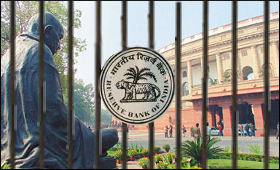|

|
Which way will Rajan go with rates post-budget?
|
|

|
|
| Top Stories |
 |
|
|
|
Biswajit Choudhury | 21 Feb, 2015
With economic data before the union budget on Feb 28 showing inflation at a five-year low, Reserve Bank of India Governor Raghuram Rajan can perhaps indulge in a belated celebration of his birthday that fell Feb 3 when he maintained the RBI repo rate at which it lends to commercial banks at 7.75 percent.
Rajan told the media that day : "Monetary policy is a long-term process. You can't hold me every 15 days saying when are you cutting rates? We have a budget coming up. Inflation data also is yet to come."
After a gap of nearly two years, he had last cut the repo rate on Jan 15.
He is currently said to be wrestling with the changes in the mode of computing the latest set of economic data.
Data earlier this week showed that wholesale price-index (WPI) inflation decelerated by 0.39 percent in January from an increase of 5.11 percent in the same month of last year. The WPI-based inflation had fallen to 0.11 percent last December.
However, the deceleration in wholesale inflation comes on the back of retail inflation gaining momentum. The consumer price index (CPI)-based inflation in January stood at 5.11 percent month-on-month.
The December retail inflation, recalculated with the new base year, was at 4.28 percent. It was at 5 percent with 2010 as the base year.
Government statisticians, however, had a bigger surprise in calculating the GDP with a new base year, which makes it harder for Finance Minister Arun Jaitley to assess the size of the fiscal stimulus required to help restore the economy.
Shifting the base year from 2004-05 to 2011-12, the Central Statistical Office last week estimated GDP growth during 2014-15 at 7.4 percent as compared to 6.9 percent in 2013-14. It has also revised the growth rate for the first half of 2014-15 to 7.4 percent from the 5.5 percent it had earlier reported under the old method.
Commenting on data procedures Rajan said last month: "We may be reaching the outskirts of the woods but we are not out of the woods yet. So I don't think any data that suggests we are out of the woods at this point, we would put too much weight on it."
He said attaining the projected inflation target of six percent by January 2016 is at risk due to expected "food price shocks as the full effects of the monsoon's passage unfold and from geo-political developments (oil prices) that could materialise rapidly."
He also turned the focus on the forthcoming budget when asked about the lack of a forward guidance in the policy review.
"The guidance remains what it was when we cut rates. Further action will depend on developments on the fiscal front and on the disinflationary process," Rajan told reporters here.
With the 2015-16 budget widely expected to boost capital spending and offer tax breaks to the manufacturing sector, Jaitley has a headache in controlling the fiscal deficit because the tax revenue earned by the central government as a percentage of the GDP has been falling over the years.
Tax revenue in 2007-2008 stood at 11.9 percent of the GDP. By 2013-2014, it had fallen to 10 percent of GDP and in 2014-2015 is expected to fall further to 9.6 percent, signifying the government's declining ability to service its accumulated debt.
Then, there is the recent history of many big nations like China, Russia and Brazil which tried full-throttle experiments in stimulus spending - and failed.
Given that Rajan is against reversing the direction he set by cutting rates in January, is he going to cut further post the budget is the question analysts are puzzled about.
Here, it is instructive to consider that less than six months ago, Rajan, who in 2005 had predicted the 2008 financial meltdown that is still affecting global economy, felt stronger in his belief that global markets now are at the risk of a crash due to the competitive loose monetary policies being adopted by developed economies. He has been warning that emerging markets are especially vulnerable to big shifts in capital flows triggered by the unprecedented monetary accommodation in rich countries.
Pointing out how all kinds of ways of infusing liquidity has created markets that tend to push asset prices probably significantly beyond fundamentals, thereby making markets much more vulnerable, Rajan has said he is more worried that altering the price of capital over an extended time span would result in distorting investment decisions and changing the nature of the economy itself.
|
|
|
| |
|
|
|
|
|
|
|
|
|
|
|
|
|
|
| |
| Customs Exchange Rates |
| Currency |
Import |
Export |
US Dollar
|
84.35
|
82.60 |
UK Pound
|
106.35
|
102.90 |
Euro
|
92.50
|
89.35 |
| Japanese
Yen |
55.05 |
53.40 |
| As on 12 Oct, 2024 |
|
|
| Daily Poll |
 |
 |
| Do you think Indian businesses will be negatively affected by Trump's America First Policy? |
|
|
|
|
|
| Commented Stories |
 |
|
|
|
|
|
| |
|